Yesterday, United States Secretary of Energy Jennifer Granholm stood alongside other federal stakeholders to announce that researchers at the U.S. Department of Energy’s (DOE) Lawrence Livermore National Laboratory reached ignition in a controlled nuclear fusion experiment. This new development is a massive breakthrough in nuclear fusion technology. Why is this important? Because it could revolutionize nuclear power as we know it.
>>>READ: America Needs a National Nuclear Fusion Strategy
To understand the importance of the DOE’s announcement of this nuclear energy breakthrough, it is important to understand the distinction between nuclear fusion and nuclear fission. Currently, nuclear power relies on a process of fission where atoms are split and the breaking process releases energy. Nuclear power is the result of applying this fission process to certain fuels, commonly uranium. Checked fission leads to the nuclear power we enjoy across the world while unchecked fission is what is used in nuclear weapons.
Nuclear fusion, on the other hand, generates energy by colliding atoms instead of splitting them. It is the same process that powers the Sun and other stars. But why would replacing nuclear fission with nuclear fusion be so important to accomplish? According to the International Atomic Energy Agency:
“The amount of energy produced from fusion is very large — four times as much as nuclear fission reactions — and fusion reactions can be the basis of future fusion power reactors. Plans call for first-generation fusion reactors to use a mixture of deuterium and tritium — heavy types of hydrogen. In theory, with just a few grams of these reactants, it is possible to produce a terajoule of energy, which is approximately the energy one person in a developed country needs over sixty years.”
Although our current nuclear process does not create much waste, switching to fusion processes would dramatically reduce created waste. But even with the benefits being very well-known, the past decades of research into nuclear fusion have been far from leading to widespread implementation.
That is, until today.
The DOE announced the success of an experiment occurring at the National Ignition Facility (NIF) of the Lawrence Livermore National Laboratory (LLNL). The NIF is the world’s most precise and reproducible laser system, and is the size of a sports stadium—approximately three football fields could fit within the facility. It contains 192 lasers that all fire simultaneously into a fusion fuel area the size of a pencil eraser, temporarily simulating the fusion conditions found within a star.
>>>READ: After Decades of Waiting, Nuclear Fusion is Moving into Full View
On Monday, December 5, “the fusion fuel stayed dense enough, hot enough, and round enough that it ignited.” Ignition means that the fusion resulted in more energy creation than the laser energy emitted to spark the ignition. After achieving the initial reaction, numbers were peer-reviewed over the past week to confirm the ignition did happen.
“The pursuit of fusion ignition in the laboratory is one of the most significant scientific challenges ever tackled by humanity, and achieving it is a triumph of science, engineering, and most of all, people,” LLNL Director Dr. Kim Budil stated. “Crossing this threshold is the vision that has driven 60 years of dedicated pursuit — a continual process of learning, building, expanding knowledge and capability, and then finding ways to overcome the new challenges that emerged. These are the problems that the U.S. national laboratories were created to solve.”
You can listen to full remarks from the DOE’s announcement here:
While it will certainly be some time before this technology advances enough to be commercially viable, there is no way to overstate the importance of this initial ignition. Jill Hruby, Under Secretary for Nuclear Security and Administrator of the National Nuclear Security Administration, put it best: “We have taken the first tentative steps toward a clean energy source that could revolutionize the world.”
Kelvey Vander Hart is a native Iowan, a member of the American Conservation Coalition, and a communications specialist at Reason Foundation.
The views and opinions expressed are those of the author’s and do not necessarily reflect the official policy or position of C3.
